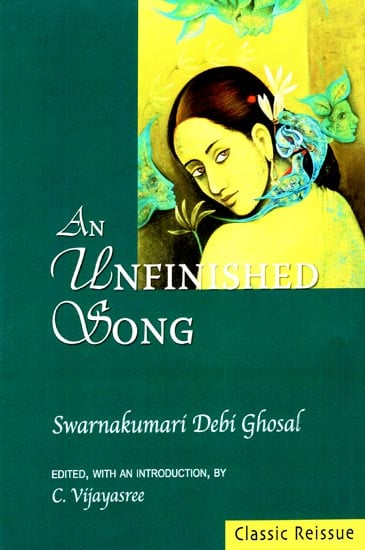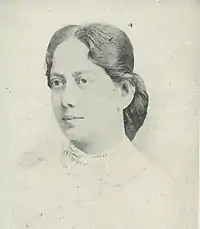Swarnakumari Devi was a poet, novelist, artist, social activist and musician from Bengal. She was one of the first prominent Bengali women writers who worked towards the alleviation of orphans and widows. Swarnakumari Devi was the elder sister of Rabindranath Tagore, who is regarded as one of Bengali literature’s first important writers.
For 30 years, she was the writer and editor of the well-known literary monthly ‘Bharati’. Deepnirban (1870), her first novel was celebrated by all. Chhinna Mukul (A Picked Bud), Snehalata or Palita (adopted girl) 1892-3, and possibly her best work Kahake, 1898, are among her other prominent works. The novel was translated as ‘The Unfinished Song’ in English.
Swarnakumari published Basanta Utsav, possibly the first opera written in Bengal, in 1879. She was home-educated but she often used forms that her more famous younger brother Rabindranath later picked up. In all, she wrote 25 books in Bengali.

Swarnakumari Devi recounts in her memoirs, how a governess was hired for her and her sisters when they were little, and she would write things on a slate for them to copy. When Debendranath Tagore, her father, found this senseless manner of teaching, he immediately stopped and hired a better teacher, Ajodhyanath Pakrashi, a male outsider in the women’s quarters, much to his sons’ pleasure and his wife’s dismay.
Swarnakumari Devi attended the annual sessions of the Indian National Congress in 1889 and 1890 with Pandita Ramabai, Ramabai Ranade, and Kadambini Ganguly. She was one of the first two members of the Bengal delegation chosen for the session. She was the first woman author of Bengal to be the recipient of the Jagattarini Gold Medal from Calcutta University. Swarnakumari Devi became the President of the Vangiya Sahitya Sammelan in 1929
The contributions of the Tagore family’s male members in the fields of music, theatre, and writing must have permeated the Jorasanko Thakur Bari, Swarnakumari’s family residence in present-day Kolkata, and struck a chord in Swarnakumari.
Swarnakumari Devi’s first novel, ‘Deepnirban’ was published in 1876 that instantly struck the nationalist roots in the population. Followed by this, she extensively worked on penning various novels, poems, plays, songs and scientific essays. In an age where women were mostly relegated to domestic chores and ‘progressively’ allowed ‘leisure-reading’, the rise of writers like Swarnakumari Devi and contemporaries like Kamini Roy, holds vital significance.
The family magazine- ‘Bharati’ was started by one of her brothers Jyotirindranath Tagore in 1877 and further edited by Dwijendtanath Tagore for seven years. For the next eleven years, Swarnakumari Devi worked as the editor of the magazine.
Also read: Kadambari Devi: Rabindranath Tagore’s Literary Companion | #IndianWomeninHistory

She married Janakinath Ghoshal, a well-educated man from a zamindar family who was the secretary of the Indian National Congress in 1868. This marked her interest and active participation in politics. She started Sakhi Samiti (society of friends) in 1896. Rabindranath Tagore penned a dance drama titled ‘Mayar Khela’ to be staged for fundraising at the Sakhi Samiti.
The society wasaimed at assisting orphans and widows in Bengal. Swarnakumari Devi attended the annual sessions of the Indian National Congress in 1889 and 1890 with Pandita Ramabai, Ramabai Ranade, and Kadambini Ganguly. She was one of the first two members of the Bengal delegation chosen for the session. She was the first woman author of Bengal to be the recipient of the Jagattarini Gold Medal from Calcutta University. Swarnakumari Devi became the President of the Vangiya Sahitya Sammelan in 1929.
From 1882 until 1886, she was President of the Ladies’ Theosophical Society, as well as the Bidhaba Shilpa Ashram, which helped widows. The Bengali Literary Conference in Kolkata elected her as the General President in 1929. Her tenure in the family magazine ‘Bharati’ popularised and explained science to Bengali women who did not have access to scientific materials. Her writing style blended everyday language with Bengali and Sanskrit to create original idioms.
The protagonists in Swarnakumari Devi’s writings always held a transgressive identity that did not conform to moral and patriarchal ideologies. Her life gives us an insight into how she deferred from the mainstream, sacrosanct and submissive representation of women in stories to one who held her own autonomy
Maroona Murmu in her article titled ‘Kahake: Swarna Debi’s Literary Resistance?’ writes, “The ‘novel-reading women’ became a trope of anxiety for the nationalist Bhadralok in nineteenth-century Bengal. Complaints were raised about the novel’s tendency to corrupt the moral sensibilities of tender minds, causing mental stultification, making women neglectful of housework, defiant and shameless. It was alleged that the identification with and imitation of the central characters in novels encouraged immoral habits and transgressive desires. It was presumed that the adherence to the imagined world of female power could destroy women’s contentment with the realities of their lives and would arouse extravagant desires and fantastic notions of happiness. The fear of ‘novel-reading women’s sexuality’ led to greater surveillance over woman’s reading habits. The conduct books advised that even if women read, it was to be for the cultivation of moral, spiritual and intellectual faculties in a systematic pursuit of character improvement, self-betterment and moral elevation. Reading was congealed with behaviour modification, a measure of right conduct, right mind and appropriate femininity.”

The protagonists in Swarnakumari Devi’s writings always held a transgressive identity that did not conform to moral and patriarchal ideologies. Her life gives us an insight into how she deferred from the mainstream, sacrosanct and submissive representation of women in stories to one who held her own autonomy. Swarnakumari effectively handles the emotions and personal relationships that are said to be at the heart of a woman’s life. She begins by defining gender-inflicted differences in love perceptions, claiming womanly authority on ‘feminine‘ sentimental qualities. The opening line of the novel, Kahake reads, ‘Man’s love is of man’s life a thing apart, it is the woman’s whole existence.’
‘Kahake’ was drawn to a liberal self-interest, individual desire, and self-actualisation through love ethos. It’s a story about finding a sense of self-determination through the intellectual knowledge of love. The protagonist Mrinalini’s love is neither an ideal to be admired nor a larger than life feeling. It’s a physical emotion that assures personal fulfilment through reciprocity.
Also read: Book Review: Jorasanko—A Semi-Fictional History Of The Tagore Women
The larger question that arises here is: how did the works of such a prominent feminist and political individual not survive through time? Why has there been an erasure of her work, despite the works of her brothers being posthumously celebrated and translated? Does literature also have a binary that allows specific domination over women and gender minority writers?
The invisibilisation of Swarnakumari Devi and many of her contemporary women writers was not just due to the language or demography, but an orchestrated social dilemma and patriarchy that shudders at the thought of women owning their agency and expressing their thoughts out of the bounds of mainstream ideologies, and holding a firm ground.
Ankita Kundu is pursuing Masters in Women’s Studies from the Tata Institute of Social Sciences, Mumbai. She writes poetry and paints in her free time. Her areas of interest include women’s rights, sexuality and socio-economic conditions, art and representation of women
Featured Image Source: Wikipedia




